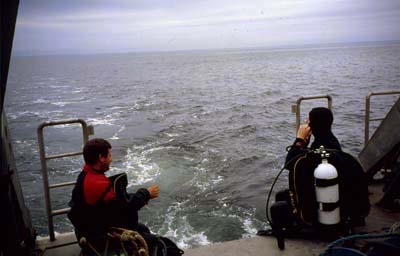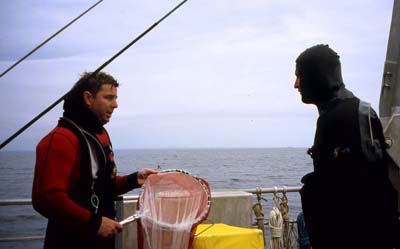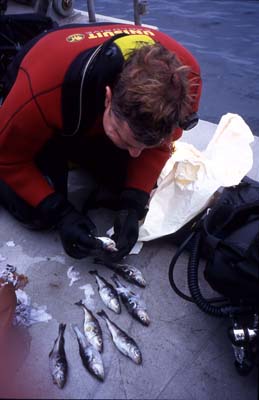The white spires of the Algonquin Hotel towered above the coastal town of St. Andrews, New Brunswick, the center of aquaculture development in Canada’s maritime provinces. Government officials and aquaculture industry representatives from Canada, Norway, and the U.S. met at the Algonquin to discuss fish farming’s future. Offshore aquaculture pioneer Chris Duffy explained his company’s plan to grow cod in extensive submerged cage systems in the open ocean.

“There’s a huge world market for cod,” said Duffy, vice president of Great Bay Aquafarms in Newington, New Hampshire. According to Duffy, Great Bay will drive down cod production costs by farming offshore. “We can create far larger systems in the open ocean, and take advantage of economy of scale,” said Duffy. Along with his Norwegian, and Canadian counterparts, Duffy hopes to turn the already popular codfish into a commodity with a farm gate value of $1.10 – 1.30 per pound, roughly equivalent to salmon. “We believe cod can be the next salmon,” he said.
Though not represented at the Algonquin meeting, some fishermen, and many environmentalists, echo Duffy’s words – “cod could be the next salmon” – as a warning.
The salmon aquaculture industry now produces over 1 million metric tons of fish annually, and since 1998 has surpassed landings from the wild salmon fishery. But opponents claim the industry’s success came at a high environmental and social cost.

“The promise of the ‘Blue Revolution’ is not the reality,” said Anne Mosness, an Alaskan fisher who runs the Go Wild Campaign for the Institute for Agriculture and Trade Policy (IATP), an environmental organization based in Minneapolis. “Chemicals, pathogens and parasites flush into the marine environment, jeopardizing water quality, wild fish, and other sea life.” According to Mosness, the harvest of small fish for feed has “caused a global protein decline.”
IATP’s director, Mike Skaladny, also warns that NMFS may permit offshore farms without environmental impact statements. “They will probably try to get by with an environmental assessment that finds ‘no significant impact,’ in which case they don’t need to do any further study,” said Skaladny. “They’ll probably end up in court over that.”
Although environmental opposition has slowed growth in U.S. salmon farming, disease outbreaks, along with space and ecosystem constraints, have curbed the industry more. Nonetheless, various federal departments such as Agriculture (USDA), and Commerce, still hope to increase the value of the country’s $1 billion dollar aquaculture industry fivefold by 2025. In order to meet that goal, government and private investors have turned to new species and the open ocean, where they believe the abundance of clean water will mitigate problems such as disease spread and nutrient loading.
Government support for open ocean aquaculture come primarily from the Commerce department’s agencies and programs: the National Oceanic and Atmospheric Administration’s Sea Grant program runs pilot projects for open ocean aquaculture; the Advanced Technology Program funds research on transgenic species for use in aquaculture, and the National Marine Fisheries Service has developed a code of conduct for sustainable open ocean aquaculture and criteria for leasing offshore tracts.
“We’ve looked at this and there is virtually no environmental risk,” said Linda Chaves, a spokesperson for the National Marine Fisheries Service.
“They still think dilution is the solution to pollution,” said Brendan O’Neill, of the Sea Web Aquaculture Clearing House, an aquaculture watchdog group founded by the Pew Charitable Trusts. He contends that the move offshore shifts the location finfish aquaculture’s problems, but does not solve them. He listed potential troubles similar to those encountered by inshore salmon farms and by the difficulty in monitoring open ocean sites. “NOAA’s initiative is misdirected on this,” he said.
The Race
Jim McVey, director of the Sea Grant program, has weighed the options and believes open ocean aquaculture offers the only rational choice for expanding U.S. seafood production. “Coastal pollution means that inshore areas will continue to lose carrying capacity. Problems with salmon farms show that they are already straddling the line of what is acceptable,” he said. “It costs a lot of money to pump water to land-based recirculating systems,” said McVey, in reference to proposals to farm fish on land. “We have to go offshore.”
He noted early successes in the offshore industry. “We’ve got a farm up and running in Puerto Rico [the privately owned Snapperfarm, which grows cobia] But this is a very tenuous time.” he said. “Snapperfarm was started by Brian O’Hanlon, 23 years old, and his uncle. They could not have done it without government support.”
McVey sees the environmental community as the key obstacle to future development. “The environmental question is what’s on everyone’s mind,” he said. Since 2001, Sea Grant has received an extra $2.6 to 5 million annually for open ocean aquaculture development. But in 2003, the agency lost that funding. Speaking from his Washington, DC, office, McVey blamed the current state of affairs on environmental lobbyists on Capital Hill. “The environmental side has spent millions fighting us,” he said. “We don’t have anything in our budget to get our side of the story out.”
The story, according to McVey, is that world fisheries landings have stalled at near 100 million tons annually. If the burgeoning human race, predicted to reach 8 billion by 2025, plans to continue eating seafood, then the additional production will have to come from aquaculture.
McVey predicts that growing fish in one percent of the U.S. exclusive economic zone (EEZ) – the ocean area between three and 200 miles offshore – could double current fisheries production in the U.S. He envisions floating fish farms in the EEZ, shepherded by mother ships. As way to reducing the industry’s reliance on wild fish for feed, McVey suggested the possibility of “growing corn inserted with the genes needed to make proteins for carnivorous fish. “
McVey, who hopes to have his open ocean aquaculture budget restored, believes technology is the key to future food security. “We are in a race,” he says, “and we’re losing by doing nothing.”
Great Bay Aquafarms has continued to pioneer the technology and biology of fish farming, in spite of failing support from Congress, and disease setbacks. For two years running, Nodavirus struck the company’s hatchery, killing all the juvenile cod. But in 2003, the Great Bay produced 150 thousand juvenile cod. At the Algonquin, Chris Duffy announced that the first of these fish had been stocked in a former salmon pen near Grand Manan, NB, an island 20 miles from St. Andrews.

Closer to home, Great Bay has provided juvenile cod for the University of New Hampshire Sea Grant Program’s experimental offshore fish farms. As the technology improves, the company hopes to invest in the further expansion of the systems.
Out on the Farm
Marine biologist Michael Chambers has worked on the cutting edge of the open ocean aquaculture for 12 years, having worked on Sea Grant Projects in the Gulf of Mexico, Hawaii and now in New Hampshire. At 8:00 on an overcast morning he boarded University of New Hampshire’s Gulf Challenger, a 50-foot research vessel moored at the Portsmouth Fishermen’s Co-op, and headed out to the experimental cages near the Isle of Shoals.

On site, Chambers and several enthusiastic graduate students suited up in dive gear and prepared to inspect the submerged cages, collect dead fish, feed the live ones, and harvest some for shipment to a National Marine Fisheries’ picnic in Washington, DC.
“Right now we have two cages out here,” said Chambers. “One has halibut, the other has haddock. We’re bringing a bigger cage out in September, for cod.”
Six miles from shore, all that shows above the surface are buoys marking the cage sites, and an automated feeder that broke down a week earlier. The 50-foot deep, 80-foot diameter cages, suspended 20 feet below the surface, offer a safer and more stable growing environment than conventional net pens near the surface. But a stretch of bad weather had kept the crew ashore and the fish went hungry.
“They haven’t eaten since Monday,” said Chambers. “The haddock are more fragile than the halibut or cod,” he added, wondering how many dead fish he would find. Carrying bags of feed, he and the grad students slid off the stern and disappeared under water, where haddock and halibut swam slowly round in the cages.
After half an hour, the crew returned. “The halibut were so hungry they were biting at us through the nets,” said Chambers. He emptied a bag of eight dead haddock on deck and began to inspect them, peeling back the gill covers. He sets aside five that appeared to have had parasite infections. “Looks like a common ecto-parasite,” he said. “We’ll have to take them back to the lab to be sure.”
Chambers noted that algae grow on the nets and entire ecosystems evolve in the farm system. Monitoring will be crucial, and part of Chambers’ work has entailed developing a video monitoring system.
Going Commercial
In September 2003, the University of New Hampshire moored what it hoped would be the first of many submerged cages filled with cod in the Gulf of Maine. “We’re almost at a commercial scale,” said Chambers.
But the economics of open ocean cod farming continue to challenge companies like Great Bay. In order to make up for the high capital investment, and cod’s low ratio of edible meat per body weight – 40 percent compared to salmon’s 60 percent – Duffy outlined a dual harvest strategy.

“In nearshore experiments we plan to stock each cage with 30 thousand juveniles,” he said, twice the level of salmon stocked in similar cages. But he plans to harvest half the fish half way through the 20 month growing cycle. Duffy’s proposed final stocking density, is lower than salmon’s, but the total capacity of the cage over a prolonged period of time is a novel experiment. In the open ocean, where U.S. developers foresee minimal disease and pollution problems, Duffy plans to push densities higher.
At the Algonquin meeting, speakers from the Norwegian industry appeared proactive, discussing preparations for potential disease problems, such as vibriosis. But the National Marine Fisheries Service, and U.S. growers have taken a wait and see attitude, confident their ability to deal with whatever diseases, if any, arise.
“They’re kidding themselves if they think they can get around it,” said Dougie McIntosh, a microbiologist from, RPC, a Fredericton lab, voicing an opinion held by many aquatic veterinarians.
“Disease is a bottleneck every aquaculture industry has to go through, and they all know that,” said McIntosh, who has worked on fish health in Scotland and Canada since 1987. “The models that they’re using are very small and controlled,” he said. “When they get to commercial scale and you’ve got several fish shedding viruses in different ways it’s going to be a different situation, and they can’t predict that.”
McIntosh, and many others point out however, that U.S. farmers lack the same level of government support that the Norwegians and Canadians have. Developing strategies for hypothetical problems would cost millions of dollars, money the fledgling industry does not have.
Ecological Economics
While the Norwegians hope to produce 200,000 tons of cod by 2010, and Chris Duffy expressed equally grand plans, some observers consider the venture to be a waste of resources.
“We’re not against aquaculture,” said Sea Web’s Brendan O’Neill. “We just don’t think carnivorous fish farming is the way to go.” O’Neill promotes growing low impact products such as shellfish and algae eating fish. He and many others contend that as long as carnivorous fish farming relies on wild fish for food it cannot be sustainable. O’Neill asserts that fish feeds use three pounds of wild fish, such as herring, to produce one pound of salmon or cod, thus undermining the rational for aquaculture development that says fish farms will help augment the world’s seafood supply.
Jim McVey responded that the feed conversion ratio for salmon is better that that of beef, poultry, or swine – and better than fish in the wild. “If we’re looking for efficiency, we’re going to find it in aquaculture,” he said.
The numbers behind McVey’s claims come in part from James Tidwell, of the University of Kentucky. Tidwell has concluded that salmon in the wild actually consume ten pounds of forage fish for every pound of weight they gain. He argues that fish farming can actually be more sustainable than natural production systems.
“Show me the numbers on growing carnivorous fish,” says Peter Tyedmers, an ecological economist at Dalhousie University in Halifax, Nova Scotia. “If they look good then let’s do it. But we need a full accounting of the costs in order to guide that decision.”
Tyedmers who has spent the last eight years conducting comparative studies of the energy costs of production systems of similar seafood products, scoffed at Tidwell’s work. “It’s simplistic,” he said, noting for instance, that on average, a midwater trawler targeting the small pelagic fish used in salmon feed, burns 110 liters of fuel per ton of fish landed, a cost Tidwell ignores.
Tyedmers uses detailed data, on energy consumption and capital costs of the salmon aquaculture and commercial salmon fishing industries, to support his contention that farming salmon consumes more energy and resources than harvesting them from the wild. He also suggests this would probably hold true for cod, depending on the harvest method used.

“The only reason to grow salmon, or any other high value carnivorous fish” he says. “is to make money. Nothing wrong with that, but don’t tell me you’re going to feed the world.”
Tyedmers’ efforts contribute to a growing body of work known as “ecological economics,” which puts values on all natural capital and ecological functions when analyzing human endeavors. Ecological economists disagree with those who believe technology can compensate for depleted resources such as fish, and clean water. “Technology cannot replace natural capital,” said Tyedmers. “The earth’s capacity to produce has limits. There are critical levels of resources and ecological function that need to be maintained, unfortunately we don’t know what they are.”
Fishermen’s Friend or Foe
In New England, fishermen found the limits of their resource in the mid 1990’s. Although the region’s fish stocks show improvements, hard times continue. According to UNH Sea Grant agent Rollie Barnaby fishermen are in desperate straits, ” and they’re not turning their backs on anything that could help them.”
The New Hampshire experiment includes mussel and scallop farming pilot projects tailored for small fishing businesses. Unlike Canada and Alaska, where fishermen have violently opposed finfish aquaculture, Portsmouth fishermen share the offshore lease with Great Bay Aquafarms and University of New Hampshire Sea Grant.
“They pay us $1800 a month to keep their boats here,” says Mike Leary, vice president of the Portsmouth Fishermen’s Co-op. “We’re interested in the mussel farming.” Leary expressed ambivalence toward the fish farm. “I don’t think cod farm will pan out economically,” he said. “We’re not worried about it.”
According to Alaska fisher Anne Mosness, they should worry. “Alaska has many abundant populations of fish that are not harvested because the salmon aquaculture industry pumps out millions of cheap fish.” New Englanders with fast rebuilding groundfish stocks may experience the same thing, she warns. Mosness also charges that the finfish aquaculture leases in the EEZ will privatize what have historically been public waters. “They feel a sense of entitlement,” she said.
But aquaculturists disregard her warnings. “Some fishermen think aquaculture will go away,” said Ivan Green, the pioneer cod farmer on Grand Manan, and a customer of Great Bay Aquafarms. “It’s not aquaculture that’ll be going away,” he said. “It’s the fishermen that’ll be going away.”
At the meeting in the Algonquin Hotel, Chris Duffy considered the environmental and fisheries arguments in a more conciliatory context, calling attention to the experience of other industries. “Eventually we will all sit down in the same room and work it out,” he said “I think in shrimp aquaculture the environmental groups and the industry got together to address concerns, and came up with strategies that worked for everyone. It was a way to get a lot of the red herring issues off the table. They came together and found co-operative solutions. That’s where we have to go.”
©2004 Paul Molyneaux
Paul Molyneaux, a freelance reporter in Whiting, Maine and a former professional fisherman, is examining the costs of salmon and shrimp aquaculture.


